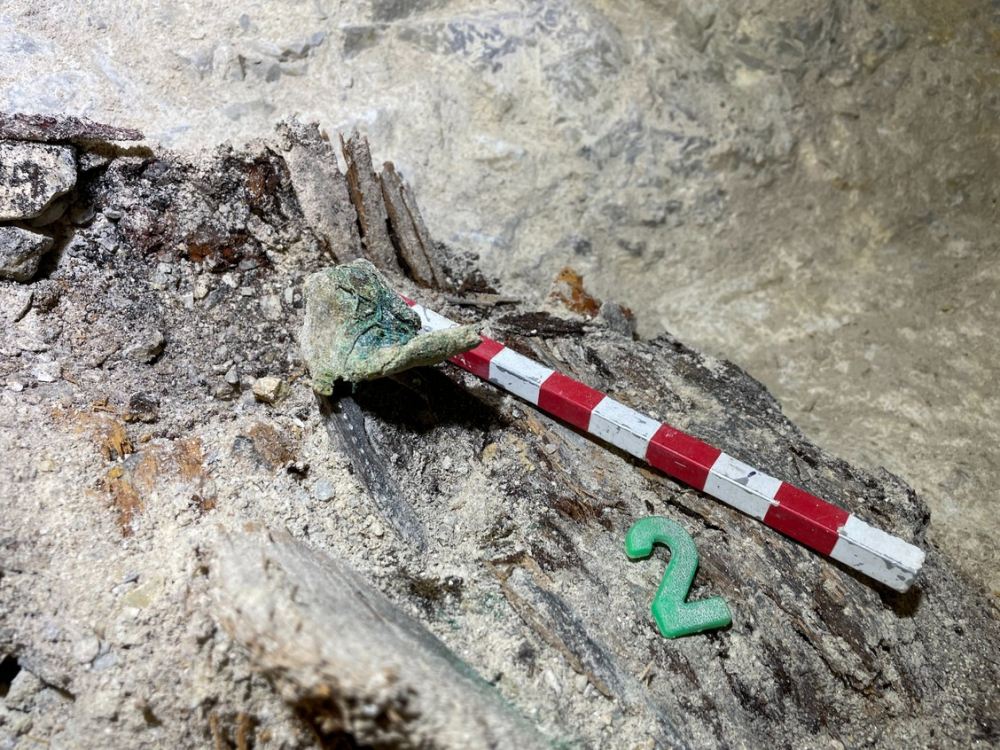



The find is particularly valuable in Hungary as few remnants of 16th-17th century clothing have survived. The restored footwear was first showcased to the public at the Night of Museums at the Biró-Giczey House, where several other archaeological finds from the Veszprém Archdiocese's renovation of 18 buildings in the castle district were also exhibited.
A high-heeled women's slipper made of greenish leather with metallic thread embroidery – this is what the 17th-century footwear found in one of the graves in the crypt of the Saint Michael Cathedral looks like. The archaeological excavation and restoration of the crypt began as part of the renovation of the Veszprém Castle District. The Veszprém Archdiocese is renovating approximately 35,000 square meters of built and 10,000 square meters of green space by the end of 2025.
The slipper may have belonged to a wealthy family member
The crypt was certainly used for burials from the 15th century and continued to be used as a burial place in the 17th century. A total of 13 graves were discovered, several of which had already been unearthed in the 1970s. "The cover plates of two coffins remained relatively intact, with decorations and inscriptions made of star-headed bronze rivets. These revealed that the resting place of family members of Ferenc Babócsay, a former captain of the Veszprém castle, had been found. We assume that the graves from a similar period excavated in 2022-2023 also belong to this family," said Dóra Hegyi, the excavation leader from the National Archaeological Institute of the Hungarian National Museum.
One of them is the young girl whose lace-trimmed silk dress and slipper have also survived in good condition – the ornate garment and footwear suggest that she was a member of a distinguished family. The 17th-century slipper was restored in recent months and will be first displayed to the public on June 22 at the Night of Museums in the Archbishop's Tourist Center at the Biró-Giczey House. Visitors can enjoy a special archaeological exhibition, including King Stephen I's first silver denar, the Lancea Regis.
What kind of shoes did women wear in the 17th century?
The nearly 400-year-old slipper is a particularly valuable find in Hungary, as few clothing items and footwear from the 16th-17th centuries have survived. The slipper spread to Europe under Turkish influence and was popular among both men and women – as evidenced by portraits and written sources. In early modern Europe, high-heeled versions also appeared – surprisingly, high-heeled footwear was initially almost exclusively worn by men and only later became popular among women.
Two other pairs of slippers were also found in graves excavated in the 1970s in the crypt of the Saint Michael Cathedral, but unlike the recently restored one, they were round-toed and flat-soled.
Interestingly, footwear, belts, and purses were also found in the ossuary unearthed in the crypt below the Saint Stephen (Franciscan) Church. "The Saint Stephen (Franciscan) Church, built in the first half of the 18th century, has a crypt running along its length with burial sites in its walls. The rammed earth floor of the crypt concealed three large ossuaries or bone chambers that were uncovered during the earthworks related to the ongoing restoration of the church. The ossuaries were partially dug into the soil layer below the floor and partially into the underlying rock surface, then covered with a thick layer of lime. These were essentially pits into which the remains of those previously buried in the crypt were transferred when there was no more space," explained archaeologist Dóra Hegyi.
The excavation leader from the Hungarian National Museum added: "In the pit, not only were the bones of the deceased found but also remnants of their clothing, such as leather footwear, belts, leather purses, and personal items, including textile religious images, devotional medals, and pectoral crosses. Some of these items have survived in excellent condition and their restoration began immediately after the excavation."
The crypt of the Saint Michael Cathedral will be renovated by 2025
The Saint Michael Cathedral was opened to the public in May 2023, but the renovation of the crypt will continue until 2025. Like most buildings in the Veszprém Castle District, the walls of the crypt are heavily damp. To address this, an archaeological study of the floor was necessary. Among other things, the 17th-century women's slipper was discovered during this excavation. After the excavation, the necessary insulation layers and mechanical systems will be installed to protect the walls.
"It was very exciting because the floor level was raised and modified several times – for example, in the Romanesque period, the Gothic period, the Baroque period, and even in the 1910s," said project manager Áron Vavra. "We found remnants of Romanesque plaster below the crypt's floor level. Our goal is to protect the walls of the crypt and the chapels from further damage due to dampness," added the project manager.
Tags: #slipper #exhibition Work in Progress 2024 #WIP2024 #17th century